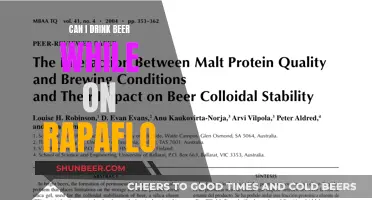
It's important to keep track of how much alcohol you're consuming, especially as different drinks contain varying amounts of alcohol. In the UK, the concept of counting alcohol units was introduced in 1987 to help people do this. One unit of alcohol equals 10ml or 8g of pure alcohol, which is the amount the average adult can process in an hour. This means that, in theory, there should be little to no alcohol left in the blood after this time, although this varies from person to person. A pint of strong lager contains 3 units of alcohol, while a pint of low-strength lager has just over 2 units. Men and women are advised not to drink more than 14 units a week regularly, which is equivalent to 6 pints of average-strength beer.
| Characteristics | Values |
|---|---|
| Number of pints of beer considered safe to drink per week | 6 pints of average-strength beer for men and women |
| Number of pints of beer considered safe to drink per day | 4 for men, 3 for women |
| Number of units in a pint of strong lager | 3 |
| Number of units in a pint of low-strength lager | 2 |
| Number of units considered safe to drink per week | 14 |
| Number of units considered safe to drink per day | 4 for men, 3 for women |
| Number of ounces in a US fluid pint | 16 ounces |
| Number of ounces in a standard US beer serving | 12 ounces |
What You'll Learn

A 'unit' of alcohol is 10ml or 8g of pure alcohol
The number of units in a drink is based on the size of the drink as well as its alcohol strength. A unit of alcohol is 10ml or 8g of pure alcohol, which is the amount of alcohol the average adult can process in about an hour. This means that, in theory, there should be little to no alcohol left in the blood of an adult after an hour, although this will vary from person to person.
The number of units in a drink can be calculated by multiplying the total volume of the drink (in millilitres) by its alcohol by volume (ABV) and then dividing the result by 1,000. For example, a pint of 4% ABV beer contains 4 (ABV%) x 568 (ml) ÷ 1,000 = 2.3 units. A pint of strong lager, which has an ABV of 5.2%, contains 3 units of alcohol, whereas the same volume of low-strength lager, with an ABV of 3.6%, has just over 2 units.
In the UK, the idea of counting alcohol units was introduced in 1987 to help people keep track of their drinking. It is recommended that men and women should not drink more than 14 units a week on a regular basis to keep health risks from alcohol at a low level. This is equivalent to 6 pints of average-strength beer or 10 small glasses of low-strength wine.
It's important to note that the definition of a standard drink or unit of alcohol varies from country to country, and there is no international consensus on how much pure alcohol it contains. In some countries, it is based on the mass of alcohol in grams, while in others, it is based on volume in millilitres or other units.
Enjoying Beer at River Riders: What You Need to Know
You may want to see also

Men: 4 drinks/day or 14/week is the limit
It's important to keep an eye on how much you drink. While drinking a couple of beers with your buddies probably won't hurt your health, drinking large amounts of alcohol can be harmful.
In the UK, the idea of counting alcohol units was introduced in 1987 to help people keep track of their drinking. One unit equals 10ml or 8g of pure alcohol, which is the amount of alcohol the average adult can process in an hour. This means that, in theory, there should be little to no alcohol left in the blood of an adult an hour after drinking, although this will vary from person to person.
The number of units in a drink depends on the size of the drink and its alcohol strength. For example, a pint of strong lager contains 3 units of alcohol, while the same volume of lower-strength lager has just over 2 units.
To keep health risks from alcohol at a low level, men are advised not to drink more than 14 units a week on a regular basis. This is equivalent to 6 pints of average-strength beer or 10 small glasses of low-strength wine. If you regularly drink this amount, it's recommended to spread your drinking over 3 or more days. If you want to cut down, try to have several drink-free days each week.
In terms of daily limits, moderate drinking for men is defined as two "standard" drinks or less per day. A standard drink, or drink-equivalent, is 14 grams of pure alcohol. This is the same as 12 ounces of beer containing 5% alcohol, or 8 ounces of malt liquor containing 7% alcohol.
It's important to note that certain drinks, such as cocktails or craft beers, may count as more than one standard drink. For example, a pint of craft beer with 7% alcohol is closer to two standard drinks. Therefore, just because moderate drinking allows up to two drinks per day, it doesn't mean you should drink every day or save up several days' worth of drinks for one day. That's when moderate drinking turns into binge or heavy drinking.
Beer and Stroke Recovery: What You Need to Know
You may want to see also

Women: 3 drinks/day or 7/week is the limit
It's important to keep an eye on how much you drink. While the odd pint of beer is unlikely to be harmful, drinking excessively can lead to serious health issues.
In the US, one "standard" drink contains about 14 grams of pure alcohol. This is typically the amount found in 12 ounces of regular beer (5% alcohol), 5 ounces of wine (12% alcohol), or 1.5 ounces of distilled spirits (40% alcohol). However, it's important to note that different types and brands of alcoholic beverages can vary in their alcohol content. For example, some microbrews have more than 5% alcohol, so drinking a 10% alcohol beer means consuming two "standard" drinks.
Weekly Upper Limits
To keep health risks from alcohol at a low level, it is recommended that women limit their consumption to no more than three drinks in one day or seven drinks per week. Drinking more than these amounts is considered "heavy" or "at-risk" drinking and increases the risk of developing health problems. About 1 in 4 people who exceed these limits have an alcohol use disorder.
Binge Drinking
Binge drinking is defined as consuming large amounts of alcohol in a short period, resulting in a blood alcohol concentration (BAC) of 0.08% or higher. For women, this typically occurs after four or more "standard" drinks within two hours.
Risky Drinking
Risky drinking refers to consuming too much alcohol too often. For women, this means having three drinks within a day. The frequency and amount of alcohol consumption matter more than the type of alcohol. Even if two people consume the same total amount of drinks in a week, their health consequences may differ. For example, drinking seven drinks in one night and abstaining the rest of the week is not the same as having one drink every night for a week. Regularly drinking heavily and frequently is considered "risky".
Health Risks of Excessive Drinking
Excessive drinking can lead to numerous health issues, including unintentional injuries, violence, risky sexual behaviors, memory and learning problems, early dementia, inflammation and damage to tissues and organs, chronic diseases (such as liver disease, heart disease, stroke, high blood pressure, and cancer), gastrointestinal issues, weakened immune system, higher risk of obesity, and mental health issues like depression and anxiety. Alcohol is linked to at least 60 different medical conditions and can also impact personal and professional life, including decreased productivity, job loss, financial issues, and relationship problems.
Benefits of Moderate Drinking
Moderate drinking may offer some health benefits, such as a lower risk of diabetes, heart disease, and Alzheimer's or dementia. However, heavy drinking can reverse these benefits. Moderate drinking is defined as one drink per day for women and up to two drinks per day for men.
Plant-Based Diet: Is Beer Consumption Permissible?
You may want to see also

More than this is 'heavy' drinking
The number of pints of beer that is safe to drink depends on several factors, including the drinker's body weight and tolerance, the alcohol content of the beer, and the frequency of drinking.
To keep health risks from alcohol at a low level, men and women are advised not to drink more than 14 units of alcohol per week on a regular basis. This equates to approximately 6 pints of average-strength beer (5% ABV) per week. It's important to note that this is just a general guideline and that the actual safe amount may vary depending on individual factors.
Heavy drinking or "at-risk" drinking is typically defined as consuming more than the recommended weekly upper limits of alcohol. For men, this is four drinks in one day or 14 per week, while for women, it's three drinks in one day or seven per week. Binge drinking, which involves consuming large amounts of alcohol in a short period, is also considered a form of heavy drinking.
The human body typically processes alcohol at the rate of one ounce per hour. This means that it can take up to three hours to process a standard alcoholic drink, depending on factors such as body weight and tolerance. Therefore, it's important to pace yourself when drinking and to allow adequate time for the alcohol to be metabolized.
Drinking more than the recommended amount can lead to several health problems, including liver damage, increased risk of stroke, heart muscle damage, and high blood pressure. Additionally, excessive alcohol consumption has been linked to an increased risk of certain types of cancer. Therefore, it's important to monitor your drinking habits and seek help if you feel you may have an alcohol use disorder.
Beer and Cholesterol: Is There a Link?
You may want to see also

ABV is a measure of alcohol volume (%)
To understand how many pints of beer are safe to drink, it is important to know what ABV is and how it is measured. ABV stands for Alcohol By Volume and is a standard measure of the volume of alcohol in a given volume of an alcoholic beverage. It is expressed as a volume percentage. In other words, it tells you what percentage of a drink is made up of pure alcohol. For example, a drink with 12% ABV means that 12% of the drink is pure alcohol.
ABV is calculated by measuring the number of millilitres of pure ethanol in 100ml of solution at 20°C. The number of millilitres of pure ethanol is found by dividing the mass of ethanol by its density at 20°C, which is 0.78945 g/ml. This calculation is used worldwide and is called the alc/vol standard.
The ABV of a drink is important to know because it can affect the taste and how likely you are to get intoxicated. A higher ABV will result in a stronger taste and will increase the likelihood of intoxication. It is also useful to know the ABV of a drink to monitor alcohol intake and keep within safe drinking limits.
In the UK, it is recommended that men and women do not regularly drink more than 14 units of alcohol per week. One unit of alcohol is equal to 10ml or 8g of pure alcohol, which is roughly the amount that the average adult can process in an hour. A pint of strong lager contains 3 units of alcohol, whereas a pint of low-strength lager contains just over 2 units. Therefore, 14 units are equivalent to 6 pints of average-strength beer.
It is important to note that the number of units in a drink depends on both the size of the drink and its alcohol strength. By knowing the ABV of a drink, you can calculate the number of units it contains. To do this, you multiply the total volume of the drink in millilitres by its ABV as a percentage and then divide the result by 1000.
For example, to calculate the number of units in a pint (568ml) of strong lager with an ABV of 5.2%, you would do the following calculation:
2 (%) x 568 (ml) ÷ 1,000 = 2.95 units
Yogurt and Beer: A Safe Pairing or Not?
You may want to see also
Frequently asked questions
Men and women are advised not to drink more than 14 units of alcohol per week, which is equivalent to 6 pints of average-strength beer.
Doctors consider drinking more than four drinks per day for men and three drinks per day for women to be "heavy" or "at-risk" drinking.
The average adult can process around 1 unit of alcohol per hour. A pint of strong lager contains 3 units of alcohol, so it would take 3 hours to process.
If you are pregnant or trying to become pregnant, you should avoid alcohol completely.







